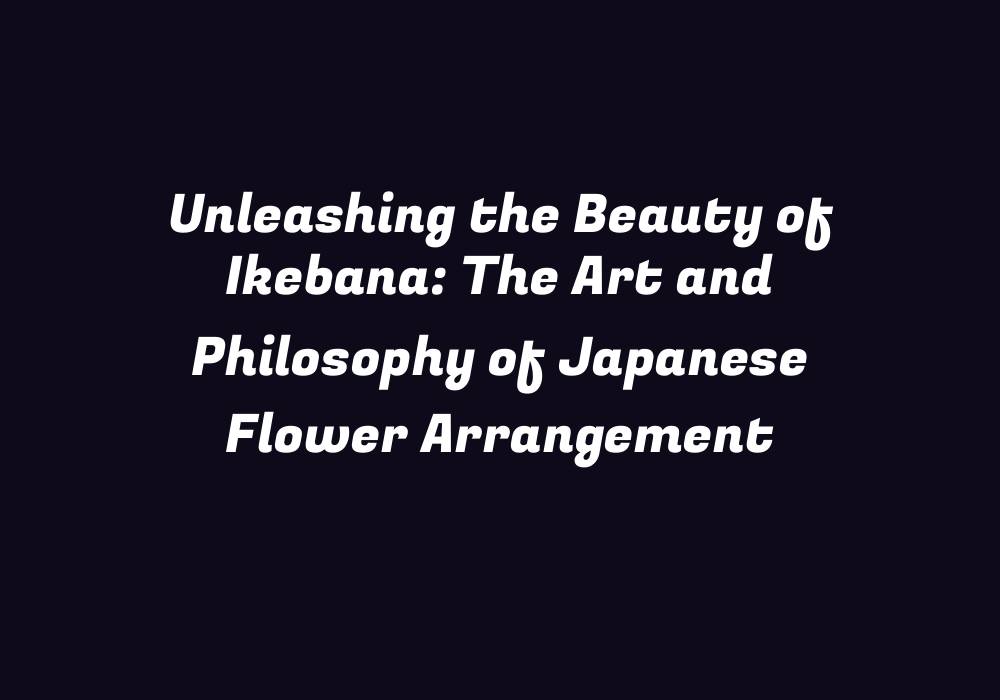Introduction to Ikebana: The Art and Philosophy of Japanese Flower Arrangement
Ikebana, the intricate art of Japanese flower arrangement, is not just about aesthetically placing flowers together in a vase. It’s an amalgamation of artistic expression, philosophy, spirituality, and traditional culture that dates back to the 16th century. With its deep roots in Zen Buddhism, Ikebana has evolved into one of the most renowned forms of Japanese art across the world.
Ikebana’s Origins
The origin of Ikebana can be traced back to ancient Chinese traditions where flowers were used as offerings and symbolic representations in ceremonies. As Buddhist monks, priests, and aristocrats visited China and India, they introduced these customs to Japan. The fusion between Japanese and foreign elements resulted in the emergence of Ikebana as a unique art form. Initially known as Kado, or “The Way of Flowers,” it transformed into its modern-day name, Ikebana, in the Edo period (1603-1868).
Philosophy and Zen Principles
Ikebana is deeply influenced by Zen Buddhist principles. The concept of “Wabi-Sabi,” embracing beauty in imperfection, is reflected through the asymmetrical arrangement of flowers that create an unpretentious harmony. Ikebana also adheres to the principle of “Ma,” meaning a subtle sense of space or silence within a composition. These principles guide the artist in creating balance and a spiritual connection between the natural world and human beings.
Types of Ikebana
There are several schools and styles of Ikebana, each with its own unique techniques, designs, and cultural influences. Some popular forms include: Sogetsu, which emphasizes the creative freedom and originality; Ikenobo, focusing on the three essential elements (ra, shin, and soe); Ohara, integrating both traditional and modern aesthetics; and Nagasawa, showcasing a more organic approach to flower arrangements. These diverse schools demonstrate the versatility of Ikebana, enabling artists to express their creative visions in various ways.
Ikebana as a Meditative Practice
For many practitioners, Ikebana is not just about creating beautiful flower arrangements but also serves as a form of meditation. The artful manipulation of flowers and other elements allows the artist to focus on their breath, emotions, and thoughts while engaging with nature’s beauty. Through this process, the artist cultivates a sense of mindfulness and self-awareness that transcends the confines of traditional flower arrangement.
Materials Used in Ikebana
Ikebana arrangements are typically created with fresh-cut flowers, foliage, branches, and various other organic materials. Commonly used blooms include chrysanthemums, orchids, irises, peonies, and lotuses due to their symbolic meanings and seasonal availability in Japan. Other elements such as mosses, grasses, and dried leaves are also incorporated into the designs for additional texture and depth. Each material used carries its own meaning, contributing to the overall aesthetic of the arrangement.
Ikebana Techniques
There are various techniques employed in creating an Ikebana composition. Some fundamental arrangements include Chabana (tea flower arrangement), Shoka (flower arrangement on a tray with tea utensils), and Nageire (free-flowing style). These methods, while based on specific guidelines and rules, provide the artist with the freedom to express their individual creativity and vision. Other techniques may involve the use of special containers or unique floral designs.
The Role of Ikebana in Japanese Culture
Ikebana has played an important role in Japanese society for centuries, from its use in religious ceremonies and rituals to its presence in traditional architecture. It has evolved as a means of self-expression and appreciation for the natural world while fostering spiritual growth and mindfulness. Through Ikebana, artists have explored various aspects of human existence, from the transient nature of life to the interconnectedness between humans and nature.
Conclusion
Ikebana is not only an art form but a reflection of Japanese culture, spirituality, and history. The beauty and significance of Ikebana lie in its ability to convey deep emotions and philosophical ideas through the simple act of arranging flowers. By understanding the art’s origins, philosophies, and techniques, one can truly appreciate the profound impact it has had on generations of artists and practitioners.
